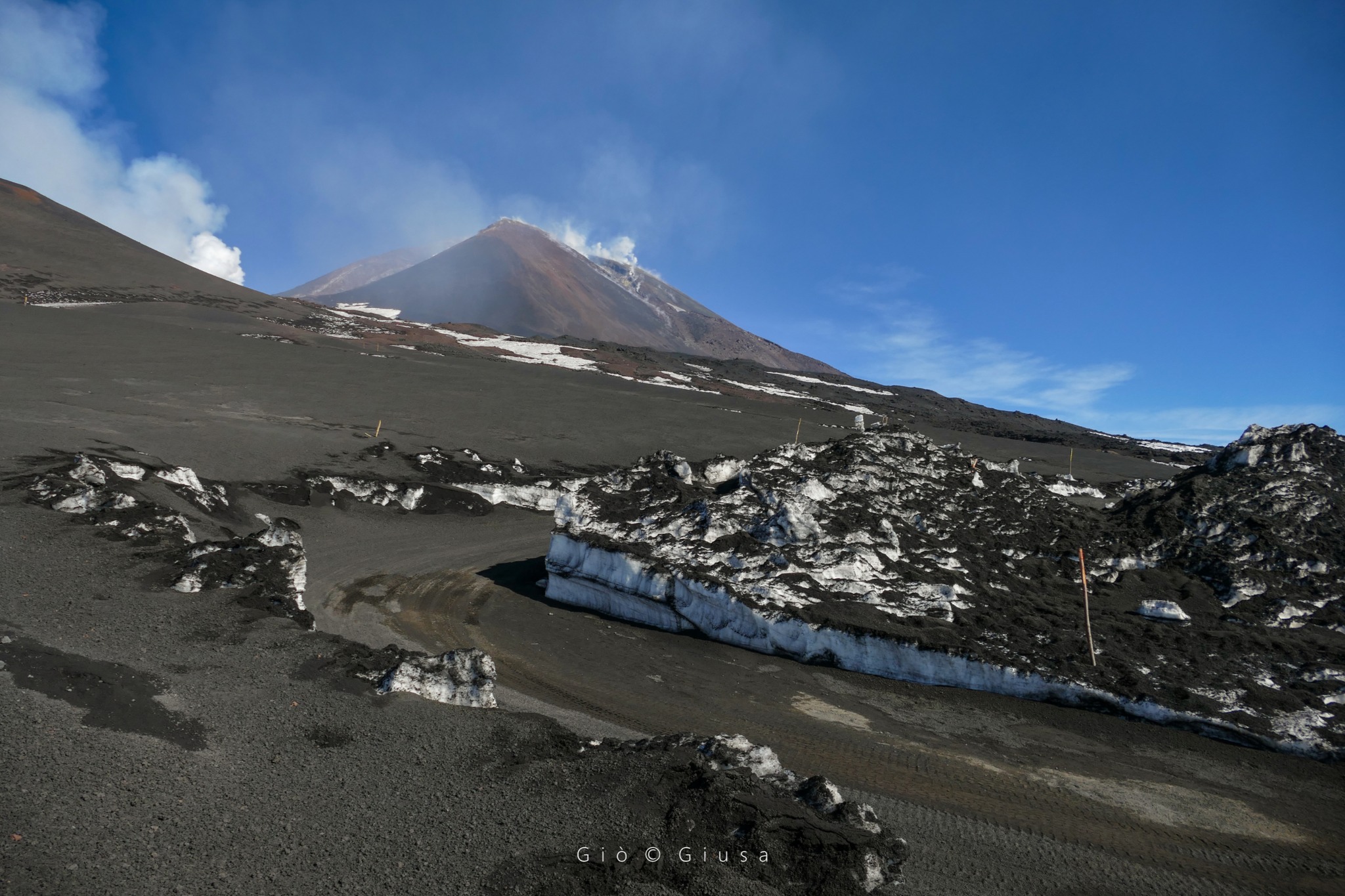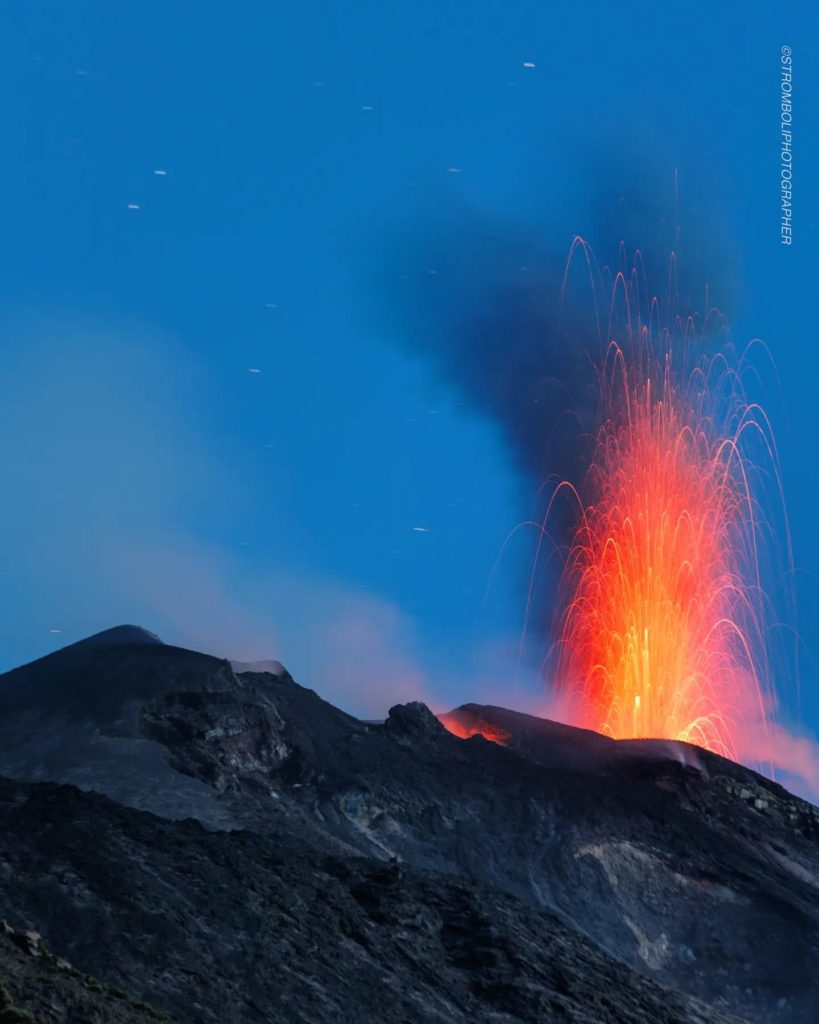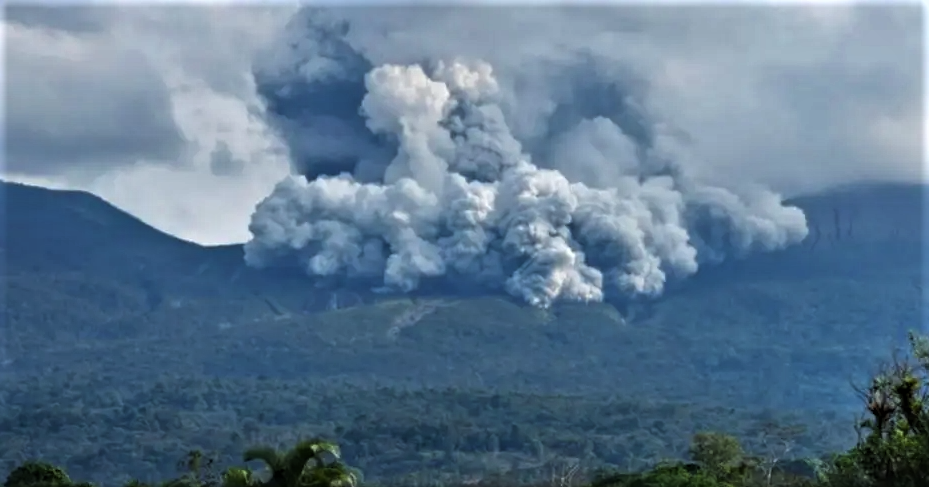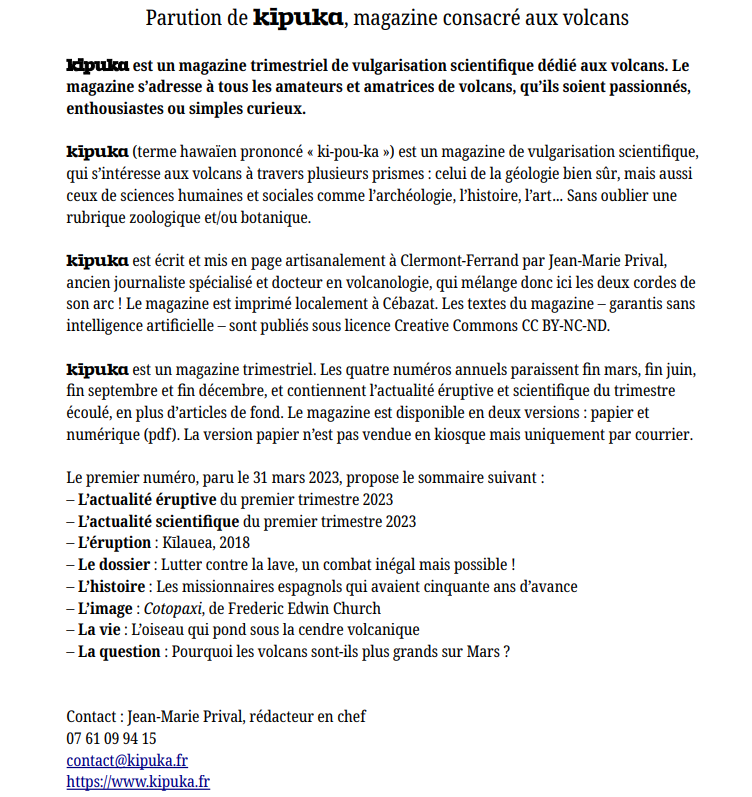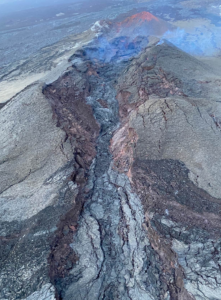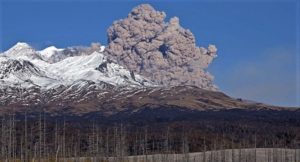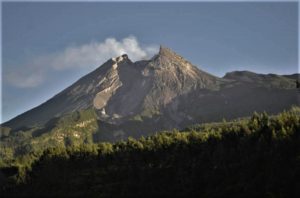May 03 , 2023.
Italy / Sicily , Etna :
MONTHLY BULLETIN APRIL 2023, (issue date 02/05/2023).
ACTIVITY STATUS SUMMARY
In the light of the monitoring data, it is highlighted:
1) VOLCANOLOGICAL OBSERVATIONS: Degassing of variable intensity from the summit craters, especially from the Bocca Nuova crater and to a lesser extent from the Southeast crater.
2) SEISMOLOGY: moderate seismic activity due to fracturing; the amplitude of the volcanic tremor remained mainly at average levels.
3) INFRASOUND: Weak infrasonic activity.
4) GROUND DEFORMATIONS: There are no significant visible variations in the time series of the Etna network tilt and GNSS stations.
5) GEOCHEMISTRY: SO2 flux at an average level
CO2 circulates at low outgassing values.
The isotopic ratio of Helium is at high levels.
The partial pressure of dissolved CO2 does not show significant variations
6) SATELLITE OBSERVATIONS: Thermal activity observed from the satellite was generally weak.
VOLCANOLOGICAL OBSERVATIONS
During the interval from April 2 to May 1, 2023, monitoring of Etna’s activity was carried out through the surveillance cameras of INGV – Osservatorio Etneo.
Overall, the state of activity of the summit craters did not show significant variations compared to what was observed during the previous month (see Rep. N.M3 /2023), and is
characterized by variable degassing at the summit craters.
In particular, the degassing of the Bocca Nuova crater was continuous and almost always had a pulsating character. The Southeast crater was affected by intense degassing produced by the eruptive vent of May-June 2022 and by the fumaroles present along the rim of the crater and the sides of the cone. The Northeast crater and the Voragine crater, on the other hand, showed only very weak fumarolic activity and remain completely obstructed.
Source : INGV.
Photo : Gio Giusa
New Zealand , Ruapehu :
Te Wai ā-moe (Ruapehu Crater Lake) has slowly cooled from 32 °C to 21 °C since January 2023. Other monitoring indicators also remain within normal ranges and the level of volcanic unrest remains low. The Volcanic Alert Level remains at Level 1 and the Aviation Colour Code remains Green.
Since our January update (RUA–2023/01) the temperature of Te Wai ā-moe (Crater Lake) has declined from 32 °C to 21 °C (Figure 1). This is consistent with a slowly declining heat flow into the lake ranging 50-150 MW. In the short term, the lake level has fluctuated with episodes of snow melt and heavy rainfall and as usual, continues to flow into the Whangaehu River headwaters.
The level of volcanic tremor recorded by our seismic equipment has remained weak since January and very few earthquakes have been located beneath the volcano. Gas scanning equipment and gas flights have measured continuous, low-to-moderate levels of gas output during the past three months.
Water samples were collected from the lake most recently on April 6th, 2023. Analyses of fluids and gases in these samples show very small changes compared to the chemistry of samples from the past several months. This indicates interactions between the volcanic rocks, fluids, and gases in the hydrothermal system beneath the lake continue at low levels. Key chemical indicators suggest the temperature of the gas inputted into the lake has been steadily decreasing, consistent with the decreasing lake temperature.
The current low levels of volcanic tremor, the very small changes in lake chemistry, and a steady decline of the lake temperature are consistent with a low level of volcanic unrest at Mt Ruapehu. As a result, the Volcanic Alert Level remains at Level 1. The Aviation Colour Code remains Green.
Source : Geonet / Ery Hughes / Volcanologist on duty .
Photo : Bradd Scott
La Réunion , Piton de la Fournaise :
Piton de la Fournaise activity
Seismicity
In April 2023, the OVPF-IPGP recorded in the Piton de la Fournaise massif in total:
• 808 superficial volcano-tectonic earthquakes (0 to 2.5 km above sea level) under the summit craters;
• 7 deep earthquakes (below sea level);
• 39 long-period type earthquakes;
• 387 landslides.
The month of April 2023 will have been marked by an increase in seismicity under the Piton de la Fournaise from around ten superficial volcano-tectonic earthquakes per day between April 1 and 12 to around twenty between April 13 and 20. april .
This seismicity culminated on April 21 with a seismic crisis during which 370 volcano-tectonic earthquakes were recorded between 3:11 p.m. and 4:20 p.m. local time. These earthquakes were located under the southwestern edge of the Dolomieu crater. This seismic crisis corresponds to an injection of magma from the reservoir to the surface but which did not reach the surface.
Following the seismic crisis of April 21, the seismicity was maintained and increased from 7 superficial volcano-tectonic earthquakes on April 22 to 32 on April 30.
Deep seismicity was also recorded throughout April, particularly under the eastern flank and on the southern edge of Enclos Fouqué.
The month of April will also have been marked by numerous landslides in the Cratère Dolomieu, at the Cassé de la Rivière de l’Est and at the level of the flow of the eruption of September-October 2022.
Deformation
In March 2023, a resumption of peak inflation was recorded. This inflation continued in April (with a maximum elongation of the terminal cone of the order of 2-3 cm in two months; and is linked to a pressurization of the superficial magmatic reservoir located at 1.5-2 km deep under the craters.
The April 21 intrusion generated only very weak deformations not visible by GPS method and recorded only on an inclinometer station located on the southern edge of the crater (variation in slope of the order of 5 micro radians).
Following the intrusion, the inflation of the building continued.
Source : OVPF
Photo : Tunnels de lave Réunion : Rando-Volcan
Italy , Stromboli :
WEEKLY NEWSLETTER, from April 24, 2023 to April 30, 2023 (issue date May 02, 2023)
ACTIVITY STATUS SUMMARY
In the light of the monitoring data, it is highlighted:
1) VOLCANOLOGICAL OBSERVATIONS: Normal Strombolian activity was observed during this period. The total hourly frequency of explosions fluctuated around average values (8 – 15 events/h). The intensity of the explosions was mainly low or medium in both the North crater area and the South Center crater area.
2) SEISMOLOGY: The seismological parameters monitored do not show any significant variations.
3) GROUND DEFORMATIONS: No significant change in ground deformation data
4) GEOCHEMISTRY: The flow of SO2 is stable at an average level
CO2 streams show low outgassing values.
The C/S ratio is on high values around 19.
There are no updates. The last sample (17/04/2023) showed a value of 4.3R/Ra.
5) SATELLITE OBSERVATIONS: The thermal activity observed from the satellite was generally weak.
VOLCANOLOGICAL OBSERVATIONS
During the observation period, the eruptive activity of Stromboli was characterized thanks to the analysis of the images recorded by the surveillance cameras of the INGV-OE at an altitude of 190m (SCT-SCV) and of the Pizzo . The explosive activity was mainly produced by 2 (two) eruptive vents located in the North Crater area and by 3 (three) vents located in the Center-South area.
Observations of explosive activity captured by surveillance cameras.
In the area of the North crater (N), with a mouth located in sector N1 and one in sector N2, low intensity explosive activity (less than 80 m in height) was observed in sector N2, low and medium (less than 150 m high) in sector N1. In both sectors, the eruptive products consist of coarse materials (bombs and lapilli), sometimes mixed with fine materials (ash). The average frequency of explosions varied from 3 to 8 events/h.
In the Center-South zone (CS), sector S2, with three active vents, showed explosive activity of mainly low and medium intensity, with the emission of fine materials sometimes mixed with coarse materials. Sector C and sector S1 did not show significant eruptive activity. The average frequency of explosions varied between 4 and 7 events/h.
Source : INGV.
Photo : Stromboli stati d’animo.
Costa Rica , Rincon de la Vieja :
Latitude: 10.83
Longitude:-85.324
Altitude: 1,916 meters above sea level
Observed activity:
A moderate phreatic eruption was recorded at 1:06 p.m. local time today, May 1, 2023. The eruption produced a column of water vapor and gas that would have reached 1,000 meters above the volcanic massif.
The eruption was seen by residents north of the volcano and recorded by seismographs, the infrasound sensor system, and Sensoria and Gavilán web cameras. Seismographs have recorded an intermittent volcanic tremor signal over the past 24 hours with a frequency spectrum between 1 and 2 Hz. Several volcano-tectonic (VT) earthquakes are recorded near the crater.
Environmental conditions:
The winds are directed towards the West. The summit of the volcano is partly cloudy.
Activity Level: Warning (2)
Source : Ovsicori
Pink notebook : Kīpuka :
It is with great joy (and a little pride too!) that we announce the birth of Kīpuka in this year 2023!
Kīpuka (Hawaiian term to be pronounced “ki-pou-ka”) is a quarterly magazine devoted to volcanoes; it is in a way a spiritual successor to the magazine Éruption Objectif Volcans, which disappeared in 2011. Even if, another era and another team oblige, its proposal will necessarily be a little different. The magazine is aimed at all volcano enthusiasts, whether they are passionate, enthusiastic or simply curious. More broadly, high school students, teachers of life and Earth sciences, media libraries… will also find it of interest – at least that is our wish.
Kīpuka is not only a magazine about volcanoes, it is also interested in the science that studies them and in the men and women who do this science, in other words in volcanology and volcanologists.
And beyond the physical understanding of volcanic phenomena, there are other disciplines, in the humanities and social sciences in particular, which are interested in volcanoes through other prisms: archaeology, history, economics… These works will also be discussed. . Finally, even if kīpuka wants to be above all a popular science magazine, it will sometimes address aspects more distant from science, cultural or artistic for example.
Source : Jean Marie Prival .

